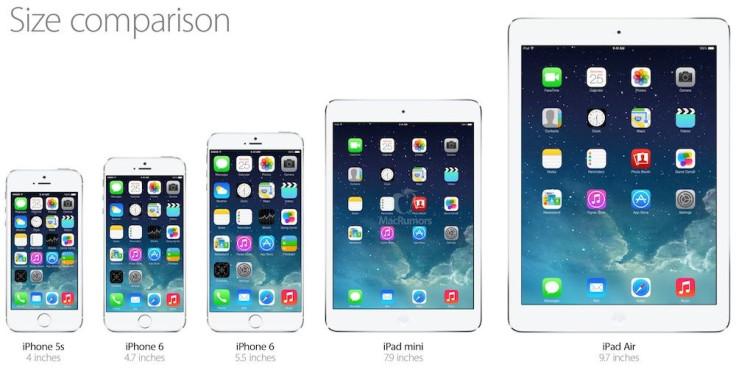Apple iPhone 6 Release Date Coming: 8 Current Rumors About the Next-Gen Smartphone

Apple’s impending iPhone 6 has been a much-discussed device since the updated version of the iPhone 5 hit shelves last September. Apple junkies scour pending patents for any new information about the company’s next device. But these reports get convoluted and twisted, deluging the Internet with myriad less-than-reputable rumors. Here is a current list of the most reliable rumors currently afloat on the iPhone 6.
Release date:
Some have speculated that a new iPhone will come as early as summer 2014. The first iPhone release came in June of 2007, and for the next three models a summer launch was standard. But in 2011 Apple had an unceremoniously long break between releases as it moved the launch date to the fall. This aligned Apple’s new device offerings with the holiday season and has been the norm ever since. While rumors are flying now, most likely the new iPhone 6 will be released in September or October 2014.
Size:
Probably one of the most popular rumors is that the iPhone 6 will come in two sizes, a 4.7-inch screen and a 5.5-inch. Currently the iPhone 5s/5c measures in at four inches, so the smaller of the two speculated sizes would represent almost a 20 percent increase in size. The larger of the two would be a whopping 38 percent larger.
What is unclear is if the smartphone will increase in length, keeping its current width, or if the increase will be an overall change in length and width. Mockups that are floating around the net suggest that the device will widen, but that is somewhat inconsistent with the iPhone’s lineage. The original iPhone was 61mm wide; the current iPhone 5s is 59mm wide. Despite the decrease of two millimeters, the iPhone’s screen has increased half an inch vertically.
Considering the history, a 5.5-inch screen stretched vertically might resemble a TV remote rather than an iPhone, so the screen’s width just might increase with the larger of the two. The 4.7-inch screen could go either way. Perhaps we will see the birth of the iPhone 6 and the iPhone 6XL.
Screen Tech:
Earlier this month a report came out suggesting that Apple will make a switch in their screen technology. The report states that both the smaller and larger iPhone 6 displays will use IGZO (Indium gallium zinc oxide) screens as opposed to LTPS (Low Temperature Polycrystalline Silicon) displays. Generally speaking, LTPS displays are the industry standard as they provide for longer battery life and brighter resolutions. But IGZO screens are gaining in popularity in the larger display markets, like tablets and phablets.
Apple has notably stuck with the LTPS screens on the iPhone line due to the faster speed of the screen and subsequently better resolution. The screen size might be the clincher, though, as larger LTPS displays are harder to produce. The report also states that the screen resolution will be around 440ppi. This supports the IGZO claim as IGZO offers higher resolution than LTPS at larger sizes.
Screen Material:
Much like the faces on high-end watches, the iPhone 6 looks like it will have a sapphire crystal display as opposed to Corning’s Gorilla Glass. Apple started making the switch to sapphire with the iPhone 5s. The camera on the 5s was covered with a sapphire lens, and the home button, which features a fingerprint scanner, was also made from the transparent crystal.
Last November, Apple announced plans to open a factory in Mesa, Ariz. After it was discovered that the tech giant had ordered a series of sapphire furnaces, it was determined that the equipment could be used to produce sapphire screens for the new device. Other practical applications arise when you consider Apple’s interest in a health-focused iWatch. Sapphire is harder than glass, even Gorilla Glass, on the Mohs scale of mineral hardness.
Internal Components:
In kind with its predecessors, the iPhone 6 will be getting an upgrade on RAM and processors. The original iPhone started with only 128MB of memory. Compare that to the speculation that the iPhone could get a push to up to 2GB of RAM. This move would bring the device in line with current Android smartphones like the Samsung Galaxy S4 or the Google Nexus 5.
The processor will be an incremental update to the next in line A8 chip, Apple’s proprietary processor line. The mobile processor line has been implemented since the iPhone 4 and the original iPad. Each successive Apple iDevice has had an upgrade to the “A” line processor; the current version A7 is employed on the iPhone 5s, iPad Air and iPad Mini. It is not a stretch to think that Apple will keep with this tradition.
Camera:
The rear-facing camera is hotly debated. Some reports suggest that the iPhone 6 will stay with the 8-MP camera it currently has, instead updating software features and stability controls. However, contradictory reposts give rise to the iPhone 6 breaking into the double digits, offering instead a 10-MP iSight camera with a larger f/1.8 aperture, capable of better low- light shots. The current iPhone 5s has an 8-MP camera with an f/2.2 aperture.
While there are conflicting reports on the rear-facing camera’s CMOS sensor, what seems to be an interesting development is the possible inclusion of a light-field camera, which allows users to refocus pictures after the image has been taken. Much like the slow-motion camera, a feature added to the existing camera on the iPhone 5s, this would confirm the software upgrade but not hardware. Another possible upgrade could be the addition of an optical stabilized camera for better movement shots. Both could be accomplished without upgrading the CMOS sensor, keeping hardware changes to a minimum.
Software:
iOS 8, the next generation in Apple’s mobile operating systems, will most likely launch with the iPhone 6. While features of iOS 8 are still murky, one possibility seems to be coming no matter what. Called Healthbook, a name coined by 9to5mac, the program seems to be focused on health and fitness features for users. Healthbook is heavily linked to rumors surrounding the iWatch, which has been recently suggested to be more of an accessory rather than a standalone device. It has also been proposed that iOS and OSX, Apple’s computer OS, may become more closely linked. However, nothing confirms that link currently.
Design:
The look of the new iPhone is in contention too. It has been reported that the iPhone 6 may become the first Apple device that is “bezel-free.” By reducing the bezel and pushing the screen to the edge, the smartphone could still employ a larger screen without increasing overall size too much. Add in the harder sapphire glass, which is more scratchproof and shatter-resistant, and you get a picture of what the new device will look like. However, the overall look will most likely stay similar to current designs. Some had speculated that the iPhone 6 would curve or have a rounded look, but Apple is not known for taking risks in the design department.
© Copyright IBTimes 2024. All rights reserved.











